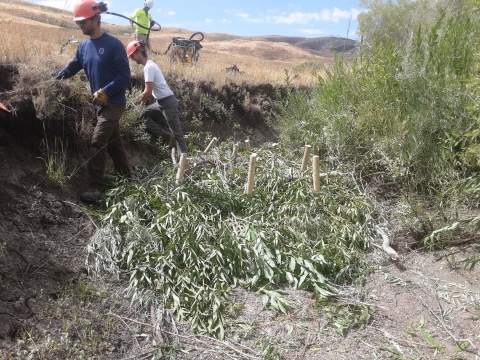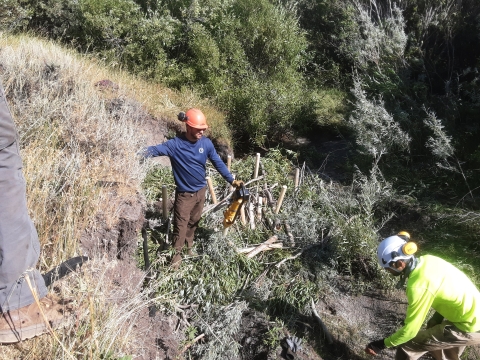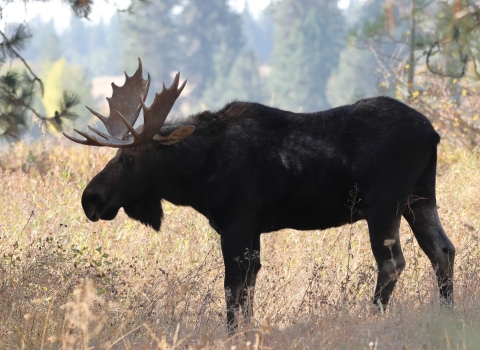The following story was written by partners at the Intermountain West Joint Venture and the original version is available on Partnering to Conserve Sagebrush Rangelands*
The Bipartisan Infrastructure Law (BIL) is a once-in-a-generation investment in the nation’s infrastructure and economic competitiveness. We were directly appropriated $455 million over five years in BIL funds for programs related to the President’s America the Beautiful initiative.
Learn more about Bipartisan Infrastructure Law (BIL) passed by Congress in 2021.
Back in the 1960s and 70s, late-season water from Succor Creek pooled up and spread out through Chipmunk Meadow, feeding a green oasis in the otherwise dry sagebrush sagebrush
The western United States’ sagebrush country encompasses over 175 million acres of public and private lands. The sagebrush landscape provides many benefits to our rural economies and communities, and it serves as crucial habitat for a diversity of wildlife, including the iconic greater sage-grouse and over 350 other species.
Learn more about sagebrush steppe of the Owyhee Uplands of southwest Idaho. This natural wet meadow complex was enhanced by a system of irrigation ditches dug by local ranchers to slow water down and seep into the soil, creating a sponge-like system that promoted grass growth for their cattle.
The cows weren’t the only ones benefiting from the greenery; other wildlife received sustenance from the native grasses and forbs provided by this wet meadow—or mesic—area. Several nearby leks of greater sage-grouse especially loved to forage in the meadow after cows had grazed the tall grasses that would otherwise be a barrier to the sweet, succulent forbs and insects key to their diet during the brood-rearing season.
At some point over the next few decades, the ditches fell into disrepair. The water wasn’t diverted and didn’t spread out over Chipmunk Meadow like it used to; each spring, the extra water in Succor Creek rushed downstream a little bit faster. In the early 2000s, a hundred-year runoff event blew out creek banks, kickstarting a cycle that promoted erosion and drove the flow of Succor Creek deeper down into the ground. By 2015, when the landscape-altering Soda Fire burned right up to its edge, the mesic habitat at Chipmunk Meadow was already in peril.
Succor Creek is not a unique case. The majority of stream systems within the Owyhee Uplands are deteriorating, largely due to the extirpation of the American beaver, wildfire, and land use change. These disturbances often cause stream channels to narrow and deepen, moving water through drainages too quickly to saturate the soil. In many areas, the flood-irrigation infrastructure installed by early settlers and ranchers who wanted to keep wet meadows green for grazing helped slow water down and create mesic areas like Chipmunk Meadows. But much of this infrastructure is over 100 years old and needs constant maintenance from ranchers who often have thousands of other acres of land to manage.
Ranchers Tony and Brenda Richards anxiously watched the cycle of erosion and drying on Succor Creek, consumed by the many pressing items on their to-do list. Besides the overtime required to keep their ranch running, the Richards are engaged in other habitat projects, like removing vegetation to create 200-foot fuel breaks on each side of certain roadways with the Boise District Office of the Bureau of Land Management (BLM), as well as working with their neighbors and using Idaho Cheatgrass Challenge funding to address invasive annual grasses. But restoring Chipmunk Meadows and the ditches that helped feed it was always a dream for the Richards, a project that sat on the shelf until the day when the funding, capacity, and know-how aligned.
“It’s a little overwhelming when there’s a long list of have-tos that come first and this work is on the wish list,” Brenda Richards said. “When partners come in and say we can help you get there—whether it’s funding or technical knowledge, or even just knowing the right engineer to work with—it really makes those dreams come true.”
In the Richards’ neck of the woods in southwest Idaho, those partners include a collection of federal, state, and private entities that have, over the past decade or so, made a habit of finding habitat work that needs to be done and pitching in what they can. The U.S. Fish and Wildlife Service Partners for Fish and Wildlife Program, the Boise District Office of the BLM, Idaho Department of Fish and Game, Idaho Department of Lands, the Natural Resources Conservation Service, and the Idaho Governor’s Office of Species Conservation, among others—all of these entities recognize the importance of maintaining intact sagebrush rangelands in southwest Idaho and the working cattle operations that depend on them.
“We’re all interested in making southwest Idaho a resilient place for wildlife and for people,” said Josh White, the Partners Biologist for the Partners for Fish and Wildlife Program who specializes in southwest Idaho’s mesic resources. “It’s a principle we can come together on to get conservation done on the ground.”
Together, these groups have invested in projects in the Owyhee Uplands that focus on replacing infrastructure like diversions, head gates, water control structures, earthen dams, pipelines, water canals, and ditches. This work also focuses on the construction and restoration of wetlands, reservoirs, and mesic habitats with low-tech process-based restoration, beaver mimicry, beaver translocation, and beaver-mitigated habitat restoration. These practices all contribute to sustaining a healthy sagebrush ecosystem in southwest Idaho—and populations of the fish and wildlife species that depend on sagebrush habitat.
Now, funding from the Bipartisan Infrastructure Law (BIL) passed by Congress in 2021 will be used to ensure these projects can continue through the Idaho Mesic Rangeland Resources Enhancement Project.
Jason Pyron, the lead on Idaho’s Partners for Fish and Wildlife program, said that BIL funding enables the Idaho PFW program to further leverage not only PFW funds but state agency partner funds to continue and extend the footprint of projects like the one at Chipmunk Meadow at a quicker pace. Restoring mesic resources is vastly important to protecting the core sagebrush habitat found in the Owyhee Uplands.
“Investing in the maintenance of the waterways that create mesic habitats will provide long-term benefits for sage-grouse during the brood-rearing season, in addition to other sagebrush obligate species and livestock,” Pyron said. “The scope and scale of these projects would not be completed in this timeline without the addition of BIL funding.”
With the Chipmunk Meadow project (officially called the Richards Chipmunk Grazing Association Project), the group of partners is trying to relieve the erosion and downcutting on Succor Creek to restore the mesic habitat which the creek feeds. The first phase of the project—getting the ditches back up and running and restoring a stockwater pond—has been completed. The second phase involved installing stream gradient structures and a new headgate to provide flow to a reestablishing historical ditch providing flood irrigation to pasture meadow. Some natural beaver dams were left in place above Chipmunk Meadow to help buffer the downstream installations from seasonal flooding.
The group, along with the Richards, will monitor the structures and streamflow to see how the work affects Succor Creek. Chris Yarbrough, the Regional Habitat Biologist for the Idaho Department of Fish and Game, said the infrastructure component is important because, while it’s a simple fix, it can make a huge difference in how habitat recovers in a wet meadow or riparian riparian
Definition of riparian habitat or riparian areas.
Learn more about riparian system.
“Installing a diversion structure structure
Something temporarily or permanently constructed, built, or placed; and constructed of natural or manufactured parts including, but not limited to, a building, shed, cabin, porch, bridge, walkway, stair steps, sign, landing, platform, dock, rack, fence, telecommunication device, antennae, fish cleaning table, satellite dish/mount, or well head.
Learn more about structure can be a big lift, and ranchers often don’t have the time, engineering expertise, necessary equipment, or the funds to handle that on their own,” Yarbrough said. “When you return flood irrigation to a lot of these meadows, it drains into creeks and draws that haven’t seen water in a long time. Then, when you follow that work up with installing low-tech riparian restoration structures in nearby creeks, you can really move the needle for habitat in these areas.”
This same group of partners also worked with nearby rancher Chris Black to do a similar restoration on an ephemeral stream that feeds several wet meadows his operation relies on. A historic canal that delivers water along the Camas Pocket Meadow system, a critically important mesic area for sage-grouse, pronghorn, and cattle operations, was cleaned and restored in 2022. In addition to cleaning the ditch, Black worked with the Partners program to install permanent check gates to efficiently irrigate the wet-meadow complex. He said that he needs to fix the ditch every five to ten years anyway. The habitat restoration work carried out by the Partners program was simply a complement to his regular operation.
“They saw an opportunity to enhance the habitat while allowing me to do what I always do,” Black said.
Black said that the financial help on the project is less important to him than just having the work be a collaborative effort with partners who have taken the time to understand him and his needs. Landowner trust in federal and even state agencies is hard-won in these parts. The work that Pyron, White, and others have put into building relationships with ranchers like Black means there’s a culture of trust and understanding that gets work on the ground much quicker when there’s funding available.
“That’s the biggest win for me because I can help build relationships and make it easier for my culture—other landowners—that want to do something with an agency,” Black said. “There will already be an understanding.”
Richards agrees. She says that the way Pyron approached the work, offering to go out to see the site on horseback with her husband Tony, made a huge difference in the couple trusting him with both the project and their community of ranching neighbors.
“He was willing to look at these things and hear from the landowner’s perspective of the site history, what the grazing association was looking for, and offer his expertise on what could be done,” she said. “The ability to have conversations about the work that needs to be done in a thoughtful way—we’re able to transfer that relationship to other landowners.”
And for agency biologists and habitat specialists, the longevity of these relationships makes projects like the BIL-funded mesic restoration work much more effective. Some of that is institutional knowledge that Yarbrough said the group of partners goes out of its way to impart to people who are new to their positions.
“This group is really good about including new partners and bringing them into meetings with landowners, helping them get the lay of the land and the projects happening in the area,” he said. “We’re always trying to include people and not just focus on what agency someone is with but rather the fact that there is one more person to help get the work done [when a new person comes in].”
The agencies’ relationships with each other are essential too, said Alex Webb, who worked with the Boise District of the BLM for two decades before filling a wildlife biologist role with Partners for Fish and Wildlife.
“I talk to people at the other agencies three days a week, getting ideas and asking for help,” he said. “Between any of us, we know the right landowner to talk to, the right practice to use, or have the funding to implement a project. Pretty much anywhere we have an in, we’re helping each other out.”
Thus, these partners have created a system that not only gets the work done but ensures that projects are effective for a long time. With the mesic work the partnership is focused on through the Idaho Mesic Rangeland Resources Enhancement project, that kind of longevity is key. Compared to other sagebrush conservation work that entities like the Partners program may engage with landowners on, White said, mesic work may require more time to show success.
“The collective partnership has become increasingly effective at removing large expanses of conifers and invasive annual grasses, and results for those projects can be relatively quick,” White said. “Mesic resources, on the other hand, can be very labor intensive to restore, but are disproportionately valuable to wildlife and human resources on the landscape. Depending on drought cycles, it may take years to realize the desired outcomes of a conservation project in a mesic area.”
Cory Mosby, a staff biologist for the Idaho Department of Fish and Game, agreed, noting that the ephemeral streams that are higher up in the watershed and feed these wet meadow systems are some of the slowest to recover but can provide benefits that affect an entire watershed.
“We’ve only been doing this type of work for four or five years, and I think this is the type of work that takes the entire span of a career to demonstrate success,” he said. “I don’t think we can even begin to grasp the benefits that a well-functioning higher order stream [like Succor Creek] can provide to an entire landscape without being able to continue this work over a period of decades.”
That’s precisely why funding from sources like BIL is so important, Pyron said. As these aren’t just one-and-done projects, finding sustainable funding to carry on projects—and the relationships that create the partnership—is critical.
“If we can’t make sure the right people have the right tools to do the work, these relationships break down,” he said. “Keeping habitat intact means keeping the relationships intact.”
For landowners like Black who want to invest in ecological systems but have to balance that with economic considerations, an agency culture that comes to meet him where he’s at is what keeps him engaged in the habitat work.
“If we start on the same page, we can work through and get things resolved much faster and it becomes easier to help the ecosystem,” he said.
Investing in partnership, as it turns out, means investing in progress. If there’s living proof of this, it may just be found in the sage grouse and cattle enjoying the grasses, insects, water, and forbs once again provided by places like Chipmunk Meadow.





